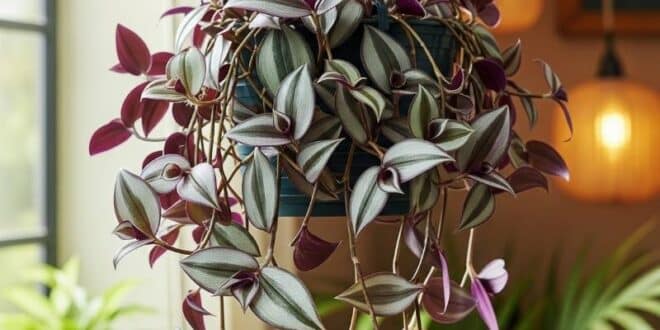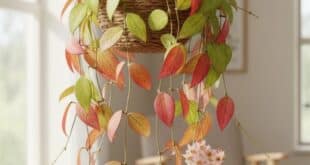Wandering Jew Plant: Your Sparkling, Trailing Gem for Easy Color!
Imagine a plant with dazzling, colorful leaves that shimmer with purple, green, and silver, trailing beautifully from any shelf or basket, and growing so easily you’ll wonder if it’s magic! That’s the captivating Wandering Jew plant. This popular gem, most commonly known as Tradescantia zebrina (though other similar plants might share the “Wandering Jew” nickname), is a true star in the houseplant world.
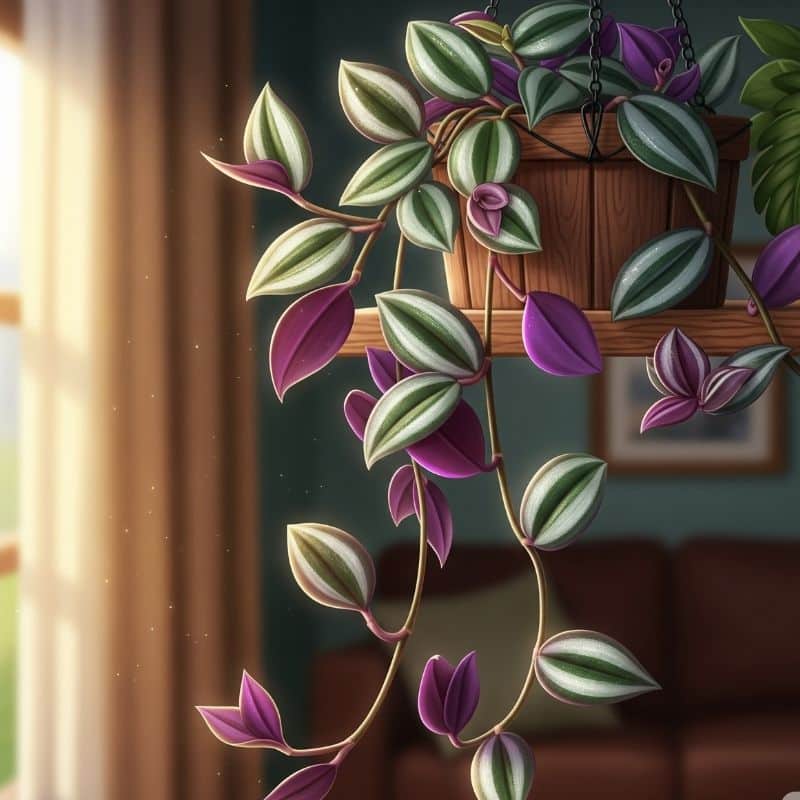
Hailing from the warm, humid forests of Central and South America, the Wandering Jew brings an incredible burst of vibrant color and lush greenery that’s perfect for both beginners and experienced plant lovers. Ready to welcome this sparkling, easy-going beauty into your home? Let’s explore everything you need to know to make your Wandering Jew absolutely thrive!
What Makes a Wandering Jew So Unique? Its Shimmering Leaves and Trailing Magic
When you look at a Wandering Jew, its leaves are what truly stand out. They’re typically oval-shaped, with a pointed tip, and boast an incredible metallic shimmer! Most commonly, you’ll see varieties with deep green and silvery stripes on top, often with a striking vibrant purple or magenta underside. This color combination is simply mesmerizing, especially as light catches the leaves.
The plant grows quickly, sending out long, graceful vines that are perfect for trailing from hanging baskets or draping elegantly down from shelves. It’s a plant that loves to spread its beauty wherever it goes!
Where Do Wandering Jew Plants Come From? South America’s Lush Forests
Your Wandering Jew’s ancestors come from the warm, humid forests of Central and South America, particularly Mexico, Central America, and Brazil. In their natural habitat, they often grow as ground cover, happily spreading along the forest floor, or gently climbing up other plants, enjoying the filtered light and consistent moisture. This background explains why they love warmth, humidity, and bright, indirect light in our homes, and why they’re so good at growing quickly!
What Are Its Other Names? “Inchplant” and Its Popularity
The most common nickname, “Wandering Jew,” refers to its vigorous, trailing growth habit, as if it’s “wandering” or spreading easily. However, because of the historical context of that name, many people now prefer to call it simply “Tradescantia” (its genus name) or “Inchplant” (referring to how quickly it grows, often an inch a week!). Its popularity comes from its stunning appearance and incredibly easy-going nature – it’s a plant that truly brightens any space.
What Kinds of Wandering Jew Plants Are There?
While Tradescantia zebrina is the most common and recognizable type, the Tradescantia family is quite diverse, offering a range of beautiful colors and textures!
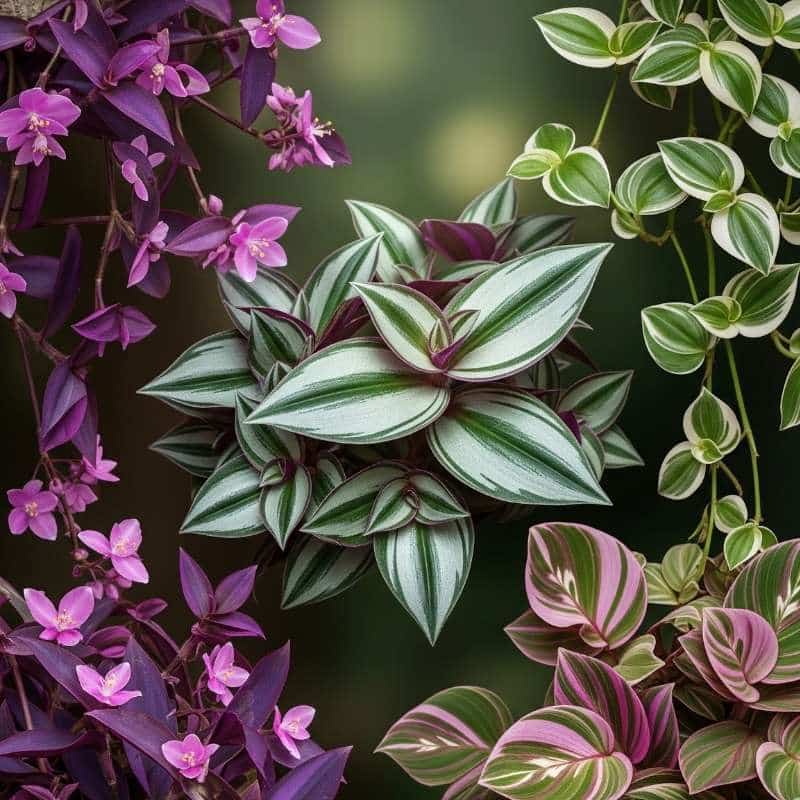
Popular Tradescantia Types: A Spectrum of Shimmer and Stripe
When people say “Wandering Jew,” they’re usually talking about Tradescantia zebrina, but here are a few popular varieties and close relatives:
| Type of Tradescantia | Key Features & Colors | Looks Like… |
| Tradescantia zebrina | Classic green and silver stripes on top, vibrant purple underside. Shimmering leaves. | A beautiful, shimmering tapestry of purple, green, and silver. |
| Tradescantia pallida (‘Purple Heart’) | Rich, deep purple leaves and stems adorned with small pink flowers, offering a bold, vibrant color with less shimmer. | A striking, uniform purple cascade. |
| Tradescantia fluminensis (‘Tricolor’ or ‘Albiflora’) | Green leaves with white, cream, or pink stripes/splashes. Often less fuzzy. | A softer, often paler variegated look, very elegant. |
| Tradescantia nanouk | Wider, thicker leaves with pronounced pink, green, and white stripes. Very showy. | A vibrant, almost painted look with bold pink streaks. |
Leaf Looks: Colors, Patterns, and Texture
The leaves are truly the stars of the show with Tradescantias! You’ll find them in amazing shades of green, purple, pink, silver, and white. The patterns can be distinct stripes, bold blocks of color, or delicate splashes. Many varieties have that signature metallic shimmer, especially on their green and silver leaves. The texture can vary too, from smooth and waxy to slightly fuzzy.
Growth Habit: Fast-Growing Trailing Vines
Wandering Jew plants are famous for being fast growers, quickly producing long, trailing vines. This makes them absolutely perfect for hanging baskets, allowing their colorful foliage to spill over the sides. They also look stunning draped from shelves, or you can even train them to climb a small trellis or moss pole if you prefer a more upright look.
How Do You Take Care of Your Wandering Jew Plant?
Caring for a Wandering Jew is wonderfully simple, making it one of the easiest and most rewarding houseplants you can own! They’re incredibly forgiving, which is always a bonus.
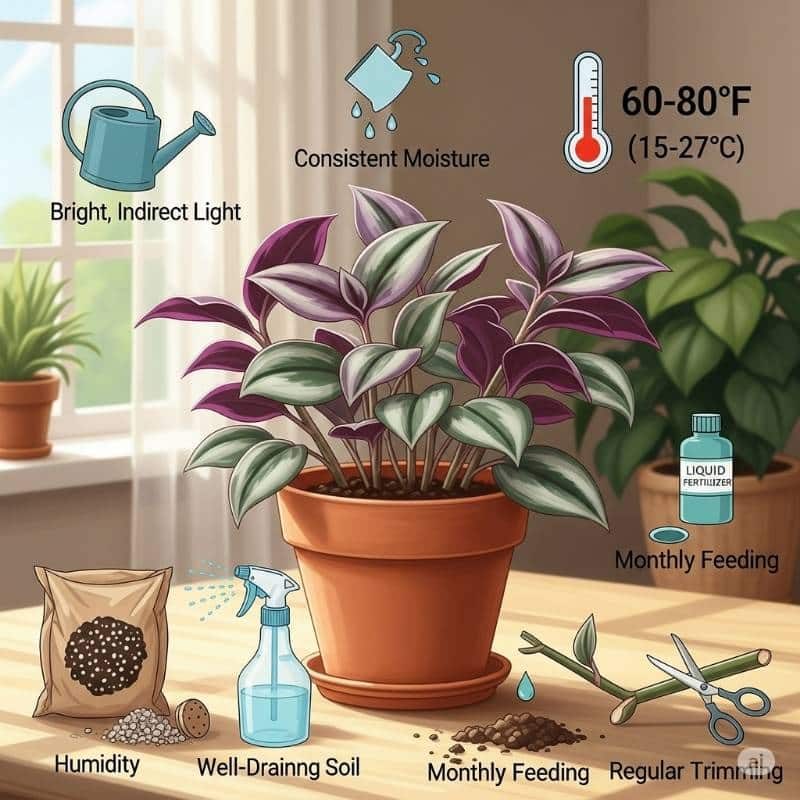
Wandering Jew Care Summary
Here’s a quick overview of what your Wandering Jew loves:
| Care Category | What Your Wandering Jew Needs |
| Light | Bright, indirect light (essential for best color, avoid harsh direct sun) |
| Watering | Keep soil consistently moist, but never soggy; water when top inch feels slightly dry. |
| Temperature | Warm, 60-80°F (15-27°C); avoid cold drafts. |
| Humidity | Moderate to high; appreciates occasional misting or grouping with other plants. |
| Soil | Well-draining, standard potting mix (e.g., general-purpose mix + perlite). |
| Pot | Drainage holes are an absolute must! |
| Feeding | Monthly during spring/summer with diluted balanced liquid fertilizer. |
| Pruning | Regular pinching/pruning for bushiness; helps maintain color. |
The Right Light: Bright, Indirect Light is Essential
Your Wandering Jew loves bright, indirect light. Think about light filtering through trees in a tropical forest – lots of brightness but no harsh direct sun scorching its delicate leaves. This kind of light is absolutely key to bringing out those vibrant purple, pink, and silver colors. If they don’t get enough light, their colors might fade, and the plant can become a bit leggy (stretched out).
Watering Smart: Keep Soil Consistently Moist, But Never Soggy!
Wandering Jew plants love consistent moisture. Water thoroughly when the top inch (about 2.5 cm) of soil feels slightly dry to the touch. The aim is to maintain consistently moist soil without letting it become soggy. Pitcher Plants dislike having their roots in standing water, as this can quickly cause root rot. Ensure your pot has excellent drainage! During the cooler, slower-growing winter months, you can reduce watering slightly.
Cozy Temperatures and Humidity, Please!
Just like their tropical home, Wandering Jew plants prefer warm temperatures, ideally between 60-80°F (15-27°C). They’re not fans of cold drafts or sudden temperature drops, so keep them in a snug spot! They also appreciate moderate to high humidity. While they can tolerate average indoor humidity, providing a bit more (especially if your home is dry) can help them truly flourish. Occasional misting or grouping them with other plants can boost humidity.
Choosing the Right Soil and Pot: Good Drainage is a Must!
Your Wandering Jew will be happiest in a well-draining, standard potting mix. A good quality indoor potting mix works great, and you can add a bit of perlite for extra aeration if you like. As with almost all plants, always pick a pot with drainage holes! Wandering Jew plants grow quickly, so you might need to repot them every year, or when they become root-bound, typically in the spring.
Feeding Your Wandering Jew: Regular Meals During Growing Season
To fuel all that vibrant growth and color, your Wandering Jew will appreciate regular feeding during its active growing season (spring and summer). Use a balanced liquid houseplant fertilizer, diluted to half strength, about once a month. As fall arrives and winter sets in, feeding can be stopped entirely.
Pruning for Bushiness and Best Color
Wandering Jew plants love to be pruned! Regular pinching back (simply snipping off the ends of the longest vines) will encourage the plant to branch out, making it much fuller and bushier. This also helps maintain those vibrant colors, as new growth tends to be the most colorful. Don’t throw away those cuttings – they’re super easy to propagate!
What Are Common Problems with Wandering Jew Plants and How to Fix Them?
Wandering Jew plants are usually quite resilient, but they’re pretty good at showing you if something’s not quite right. Here’s what to look for:
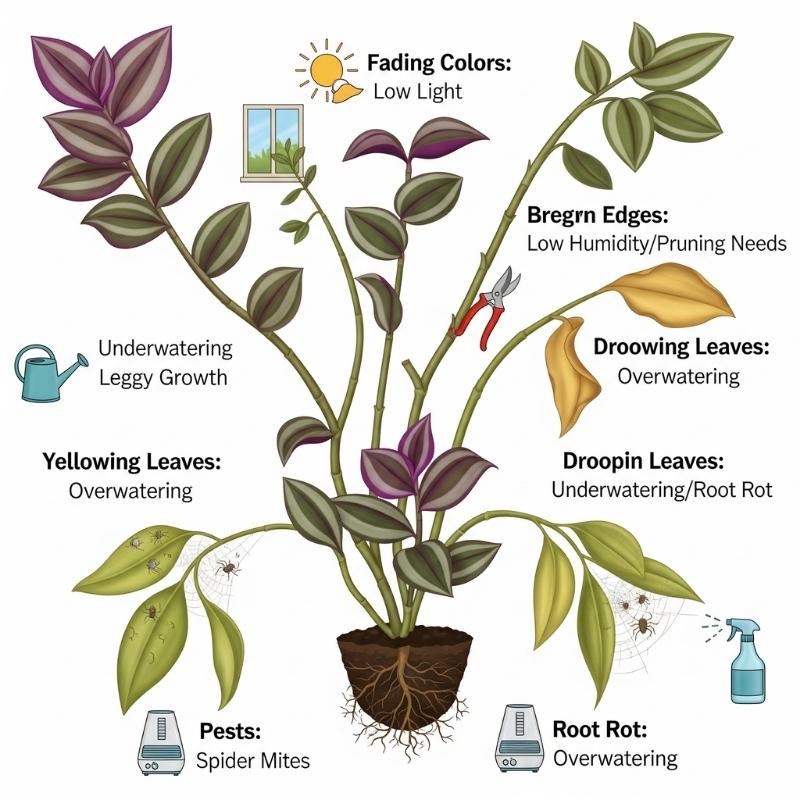
Common Wandering Jew Problems & Solutions
| Problem | What It Looks Like | Common Cause(s) | How to Fix |
| Fading Colors/Losing Stripe | Leaves turn mostly green, lose vibrancy | Not enough light | Move to brighter indirect light. |
| Leggy Growth/Sparse Leaves | Long stems, leaves far apart, looks thin | Not enough light | Move to brighter indirect light; prune back leggy sections to encourage bushiness. |
| Brown/Crispy Edges/Tips | Dry, brittle leaf edges/tips | Underwatering, very low humidity | Water consistently; if air is very dry, increase humidity. |
| Yellowing or Mushy Leaves | Leaves soft, squishy, often yellow | Overwatering (most common), root rot | Let soil dry out more; ensure good drainage. |
| Drooping Leaves | Leaves look limp/sad | Underwatering (thirsty) OR overwatering (root rot) | Check soil moisture: if dry, water; if soggy, let dry/check roots. |
| Pests | Tiny webs, sticky residue, small bugs | General plant stress, poor air circulation | Inspect regularly. Treat with insecticidal soap or neem oil. |
| Root Rot | Mushy stems at soil line, foul smell | Persistent overwatering | Prevent with proper watering & drainage. If severe, repot, trim rotten roots. |
Is the Wandering Jew Plant Toxic? Safety for Pets
Yes, it’s very important to know: Wandering Jew plants are considered toxic if ingested. They contain compounds that can cause irritation.
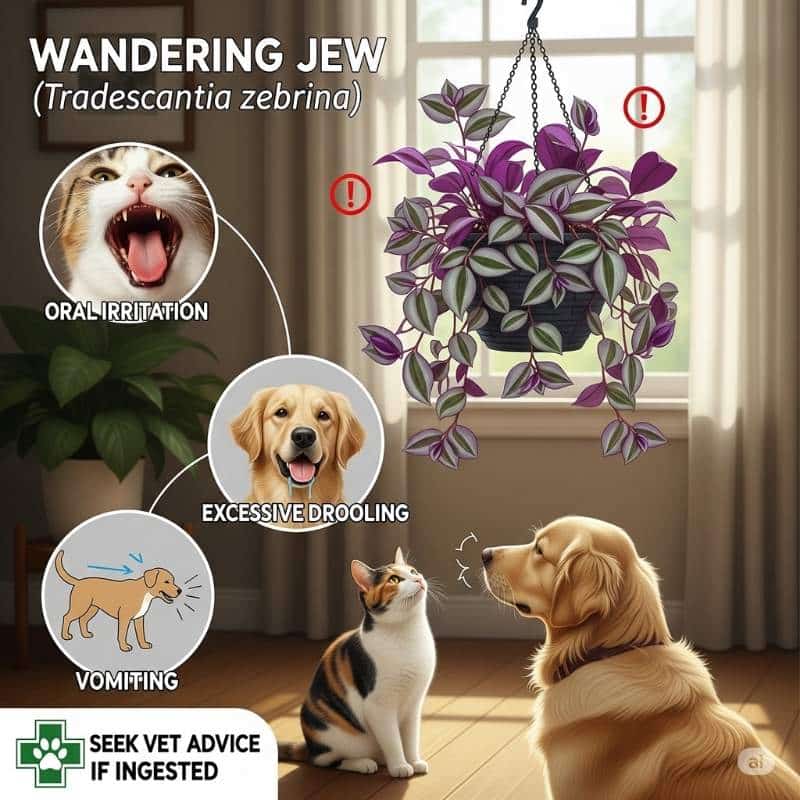
If your cats, dogs, or other pets chew on a Wandering Jew plant, you might see symptoms like:
- Oral irritation: Redness, swelling, or pain in the mouth, tongue, and lips.
- Excessive drooling.
- Vomiting.
- Difficulty swallowing.
While usually not life-threatening, the irritation can be quite uncomfortable for your pets. So, it’s highly recommended to keep Wandering Jew plants out of reach of curious pets and small children. Place them in hanging baskets or on high shelves where they can’t be reached. If you think your pet has eaten any part of a Wandering Jew and shows symptoms, please contact your veterinarian immediately for advice.
Wandering Jew Plant for Home Decor: Versatility and Sparkling Color
The Wandering Jew plant is an absolute dream for home decor, thanks to its versatile growth and dazzling, colorful foliage!
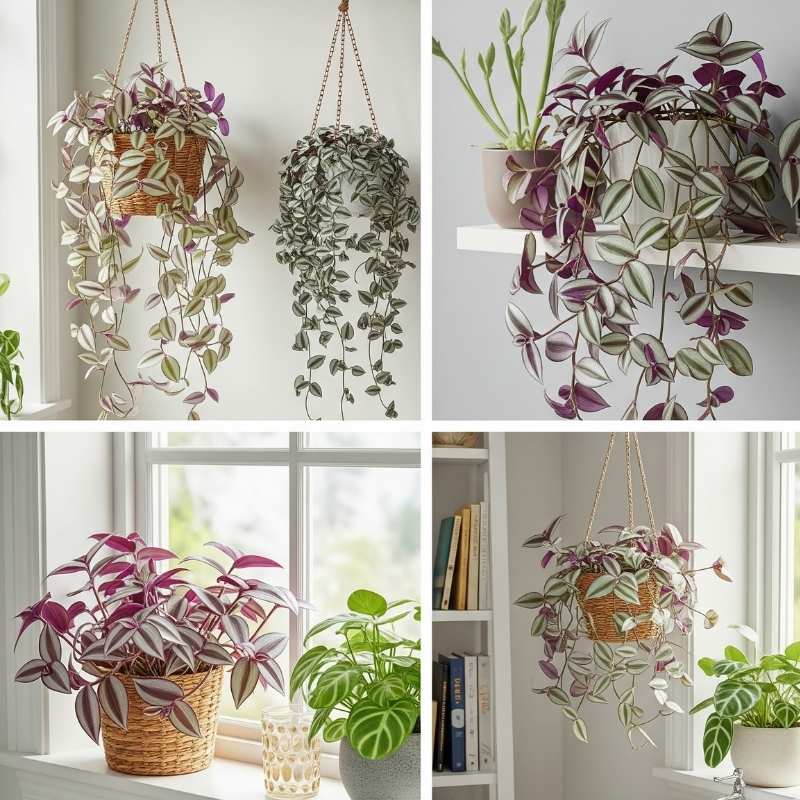
Perfect for Hanging Baskets and High Shelves
With its long, graceful vines and vibrant leaves, the Wandering Jew is absolutely fantastic for hanging baskets or placing on high shelves. Its beautiful foliage will elegantly spill over the sides, creating a stunning visual effect.
Adding a Pop of Color to Any Corner
Its sparkling leaves and range of colors make it perfect for adding a bright and cheerful pop of color to any room. It can brighten up a windowsill, add flair to a bookshelf, or bring life to a bathroom.
Great for Styling and Mixing with Other Plants
The Wandering Jew’s unique colors make it wonderful for mixing with other plants, adding texture and contrasting hues to your plant arrangements. You can also easily propagate cuttings to fill in bare spots or create new displays!
The Allure of Wandering Jew Plants: Easy-Going, Colorful, and So Rewarding!
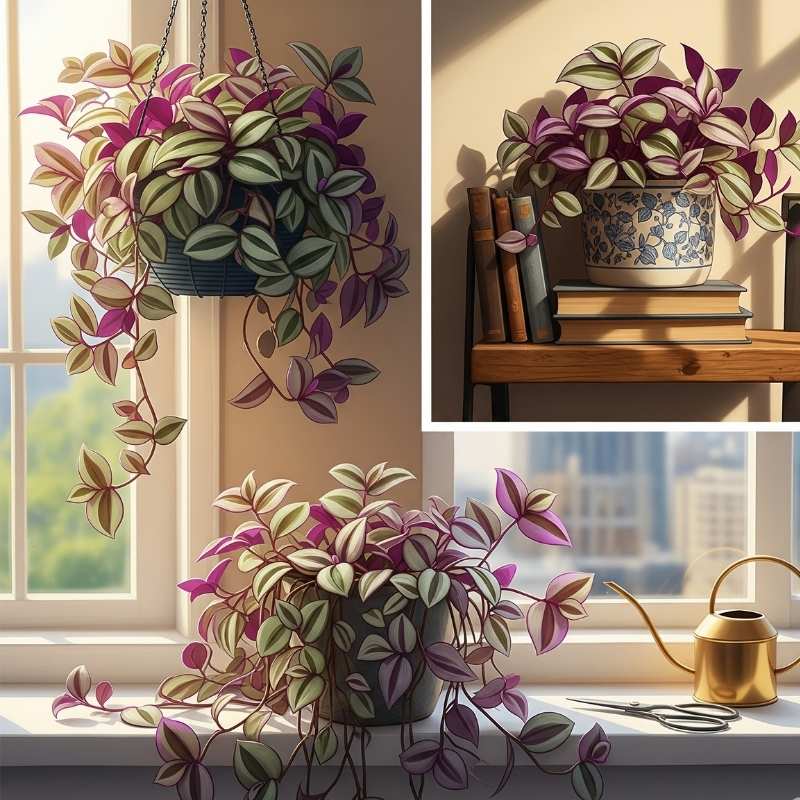
The Wandering Jew plant truly stands out as a wonderfully flexible and rewarding houseplant. It offers an unbeatable blend of effortless care, stunning beauty with its shimmering, colorful leaves, and incredible versatility in how you can display it. Whether you’re a busy bee, a plant care beginner, or simply seeking a dependable and stunning green companion that offers vibrant, continuous color, the Wandering Jew is an excellent choice. It’s a testament to how much beauty a simple, easy-going plant can add to your life!
Frequently Asked Questions (FAQ) About Wandering Jew Plants
Still have some questions about your wonderful Wandering Jew plant? Here are some common ones that might help you out!
Q1: How often should I water my Wandering Jew?
A1: Water your Wandering Jew when the top inch (about 2.5 cm) of soil feels slightly dry to the touch. They love consistent moisture but absolutely hate soggy roots! Always ensure your pot has excellent drainage. You’ll probably need to water more frequently during the warmer months and less often in the winter.
Q2: Why are my Wandering Jew’s leaves losing their color or stripes?
A2: If your variegated (striped/colorful) Wandering Jew is looking plain green or its colors are dull, it’s usually a sign that it’s not getting enough light. The vibrant colors need bright, indirect light to develop fully.
- The Fix: Move it to a brighter spot with indirect light.
Q3: Is the Wandering Jew plant safe for my pets?
A3: No, the Wandering Jew plant is considered toxic if ingested by cats, dogs, and other pets. It contains irritating compounds that can cause oral pain, drooling, and vomiting. It’s best to keep them out of reach.
Q4: How do I make my Wandering Jew plant look fuller and not leggy?
A4: Wandering Jew plants tend to get leggy over time, especially if they don’t get enough light. The best way to make them fuller is through regular pruning/pinching. Just trim the ends of the longest vines right after a leaf node. This encourages new growth and branching, making the plant denser.
Q5: Can I grow a Wandering Jew in water?
A5: Yes, absolutely! Wandering Jew cuttings root very easily in water. You can often keep them growing in water long-term, just remember to change the water regularly (every week or two) to keep it fresh and add a tiny bit of liquid fertilizer occasionally for nutrients.
Q6: Why are my Wandering Jew leaves turning brown and crispy?
A6: Brown and crispy leaves or tips are usually a sign of underwatering (you’ve let the soil get too dry) or very low humidity.
- The Fix: Adjust your watering schedule to be more consistent, and consider boosting humidity around the plant if your home is very dry.
Q7: How fast does a Wandering Jew plant grow?
A7: Wandering Jew plants are known for being very fast growers! With good light and consistent moisture, their vines can lengthen quite rapidly, allowing you to enjoy that beautiful cascading effect quickly.
Q8: Can I put my Wandering Jew outside?
A8: Yes, you can! In warm weather (above 50°F / 10°C), you can place your Wandering Jew outdoors in a bright, shady spot. Just be sure to bring it back indoors before the temperatures drop in the fall, as it isn’t frost-tolerant. In some very warm climates, it can even become invasive outdoors, so plant responsibly.
Q9: What kind of soil is best for a Wandering Jew?
A9: A well-draining, standard indoor potting mix is perfect for Wandering Jew plants. You can add a bit of perlite for extra drainage if you want to make it even happier. The key is to make sure the soil doesn’t remain soggy.

